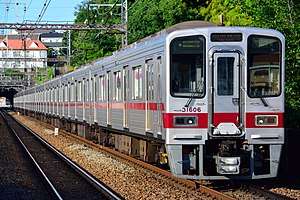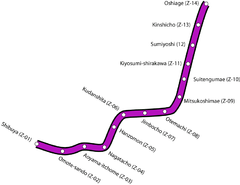Tokyo Metro Hanzōmon Line
The Tokyo Metro Hanzōmon Line (東京メトロ半蔵門線, Tōkyō-metoro-hanzōmon-sen) is a subway line in Tokyo, Japan, owned and operated by Tokyo Metro.
| Tokyo Metro Hanzōmon Line | |||
|---|---|---|---|
| Overview | |||
| Native name | 東京メトロ半蔵門線 | ||
| Type | Heavy rail rapid transit | ||
| Locale | Tokyo | ||
| Termini | Shibuya Oshiage | ||
| Stations | 14 | ||
| Daily ridership | 1,006,682 (2017)[1] | ||
| Operation | |||
| Opened | August 1, 1978 | ||
| Owner | Tokyo Metro | ||
| Depot(s) | Saginuma | ||
| Rolling stock | Tokyo Metro 8000 series Tokyo Metro 08 series Tokyu 2020 series Tokyu 5000 series Tokyu 8500 series Tobu 30000 series Tobu 50050 series | ||
| Technical | |||
| Line length | 16.8 km (10.4 mi) | ||
| Track gauge | 1,067 mm (3 ft 6 in) | ||
| Electrification | 1,500 V DC overhead catenary | ||
| Operating speed | 80 km/h (50 mph) | ||
| |||
Overview
The 16.8 km line serves the wards of Shibuya, Minato, Chiyoda, Chūō, Kōtō, and Sumida. Despite being shorter in length than nearly all other Tokyo subway lines, the Hanzōmon Line operates some of the longest through services with private railways – namely Tōkyū Corporation and Tobu Railway. The line is connected to Tōkyū Den-en-toshi Line at Shibuya Station to the south, and to the Tobu Skytree Line at Oshiage to the north. Through trains operate between Chūō-Rinkan on the Tōkyū Den-en-toshi Line and Tōbu-Dōbutsu-Kōen on the Tobu Skytree Line, onward to Kuki on the Tobu Isesaki Line and Minami-Kurihashi on the Tobu Nikko Line.[2] Through-service trains between Chūō-Rinkan and Minami-Kurihashi cover a total distance of 98.5 km in a single run – more than five times the length of the Hanzōmon Line alone.
The Hanzōmon Line has direct interchanges with all other Tokyo Metro and Toei lines. It connects with the Tokyo Metro Ginza Line at five stations (the four stations between Shibuya and Nagatachō, as well as at Mitsukoshimae Station.
The line is named after the west gate of the Imperial Palace (Hanzōmon), which in turn is named after 16th century samurai Hattori Hanzō, who was important to the founding of the shogunate which built the palace. The Hanzōmon Line's color on maps and station guides is purple, and stations carry the prefix "Z" followed by a number.
According to the Tokyo Metropolitan Bureau of Transportation, as of June 2009 the Hanzōmon Line is the sixth most crowded subway line in Tokyo, at its peak running at 173%[a] capacity between Shibuya and Omotesandō stations.[3]
Station list
- All stations are located in Tokyo.
- All services stop at every station.
| No. | Station | Japanese | Distance (km) | Transfers | Location | |
|---|---|---|---|---|---|---|
| Between stations |
From Shibuya | |||||
| Z01 | Shibuya | 渋谷[* 1] | - | 0.0 |
|
Shibuya |
| Z02 | Omote-sando | 表参道 | 1.3 | 1.3 |
|
Minato |
| Z03 | Aoyama-itchome | 青山一丁目 | 1.4 | 2.7 |
| |
| Z04 | Nagatacho | 永田町 | 1.4 | 4.1 |
|
Chiyoda |
| Z05 | Hanzomon | 半蔵門 | 1.0 | 5.1 | ||
| Z06 | Kudanshita | 九段下 | 1.6 | 6.7 |
| |
| Z07 | Jimbocho | 神保町 | 0.4 | 7.1 |
| |
| Z08 | Ōtemachi | 大手町 | 1.7 | 8.8 |
| |
| Z09 | Mitsukoshimae | 三越前 | 0.7 | 9.5 |
|
Chūō |
| Z10 | Suitengumae | 水天宮前 | 1.3 | 10.8 |
| |
| Z11 | Kiyosumi-shirakawa | 清澄白河 | 1.7 | 12.5 | E Toei Oedo Line (E-14) | Kōtō |
| Z12 | Sumiyoshi | 住吉 | 1.9 | 14.4 | S Toei Shinjuku Line (S-13) | |
| Z13 | Kinshicho | 錦糸町 | 1.0 | 15.4 |
|
Sumida |
| Z14 | Oshiage | 押上[* 3] | 1.4 | 16.8 |
| |
- Shibuya is shared by both Tokyu Corporation and Tokyo Metro; Tokyu Corporation manages the station.
- Due to the distance between the Ginza and Hanzomon/Den-en-toshi lines at Shibuya, transfers between the two lines are announced at Omote-sando.
- Oshiage is shared by both Tobu Railway and Tokyo Metro; Tokyo Metro manages the station.
Rolling stock
Current
- Tokyo Metro 8000 series
- Tokyo Metro 08 series
- Tokyu 2020 series
- Tokyu 5000 series
- Tokyu 8500 series
- Tobu 30000 series
- Tobu 50050 series
 Tokyo Metro 8000 series
Tokyo Metro 8000 series Tokyu 2020 series
Tokyu 2020 series Tobu 30000 series
Tobu 30000 series Tobu 50050 series
Tobu 50050 series
Former
- Tokyu 2000 series
- Tokyu 8590 series
History
The Hanzōmon Line was first planned in 1971, along with the Chiyoda Line and Yūrakuchō Line, as a reliever line for the heavily congested Ginza Line. Its initial routing was from Futako-Tamagawa Station on the Tōkyū Den-en-toshi Line to a new station in the Fukagawa district of Kōtō Ward. In 1985, a second draft plan from the Ministry of Transportation moved the Hanzōmon Line's final terminus to Matsudo, Chiba Prefecture. During the planning stage, it was known as Line 11.
Construction began in 1972 and the majority of the line was expected to open in 1975. However, the poor economy in Japan had depressed the Teito Rapid Transit Authority's receipts during that time, which considerably delayed the construction of new lines. On August 1, 1978, the first section of the Hanzōmon Line finally opened from Shibuya to Aoyama-itchōme, including through services with the Den-en-toshi Line. It was then extended to Nagatachō in September 1979.
However, the next extension posed political problems, as the original plan had the line run directly under the Imperial Palace to Ōtemachi. TRTA decided to divert the route around the north side of the Imperial Palace, which required the construction of three new stations. An eminent domain battle erupted with landowners along the proposed route, which delayed the completion of the next stage of the line. Hanzomon Station opened in December 1982, and the full extension around the Imperial Palace, terminating at Mitsukoshi-mae, was not completed until January 1989. Since then, there have been further extensions to Suitengu-mae (November 1990) and finally Oshiage (in March 2003), the latter also enabling through service with the Tobu Skytree Line.[4]
The Ministry of Transportation estimated in 2000 that the line would be extended to Matsudo in 2015. However, Tokyo Metro stated in its initial public offering that its construction operations would cease once the Fukutoshin Line is completed, which casts some doubt as to whether the Matsudo extension will actually be built.
Notes
a. ^ Crowding levels defined by the Ministry of Land, Infrastructure, Transport and Tourism:[5][6]
- 100% — Commuters have enough personal space and are able to take a seat or stand while holding onto the straps or hand rails.
- 150% — Commuters have enough personal space to read a newspaper.
- 180% — Commuters must fold newspapers to read.
- 200% — Commuters are pressed against each other in each compartment but can still read small magazines.
- 250% — Commuters are pressed against each other, unable to move.
References
- Shaw, Dennis; Morokawa, Hisashi (1992). Tokyo Subways. Osaka, Japan: Hoikusha Publishing Co., Ltd. ISBN 4-586-54045-1.
- Tokyo Metro station ridership in 2017 Train Media (sourced from Tokyo Metro) Retrieved July 23, 2018.
- Tobu Timetable, 16 March 2013, p.168-176
- Metropolis, "Commute", June 12, 2009, p. 07. Capacity is defined as all passengers having a seat or a strap or door railing to hold on to.
- The 地下鉄 [The Subway]. Japan: Sansuisha. 2004. p. 28. ISBN 4-06-366218-7.
- https://www.mlit.go.jp/tetudo/toshitetu/03_04.html
- Kikuchi, Daisuke (6 July 2017). "Tokyo plans new effort to ease commuter hell on rush-hour trains". The Japan Times. Archived from the original on 6 July 2017.
External links
- Tokyo Metro website (in English)
